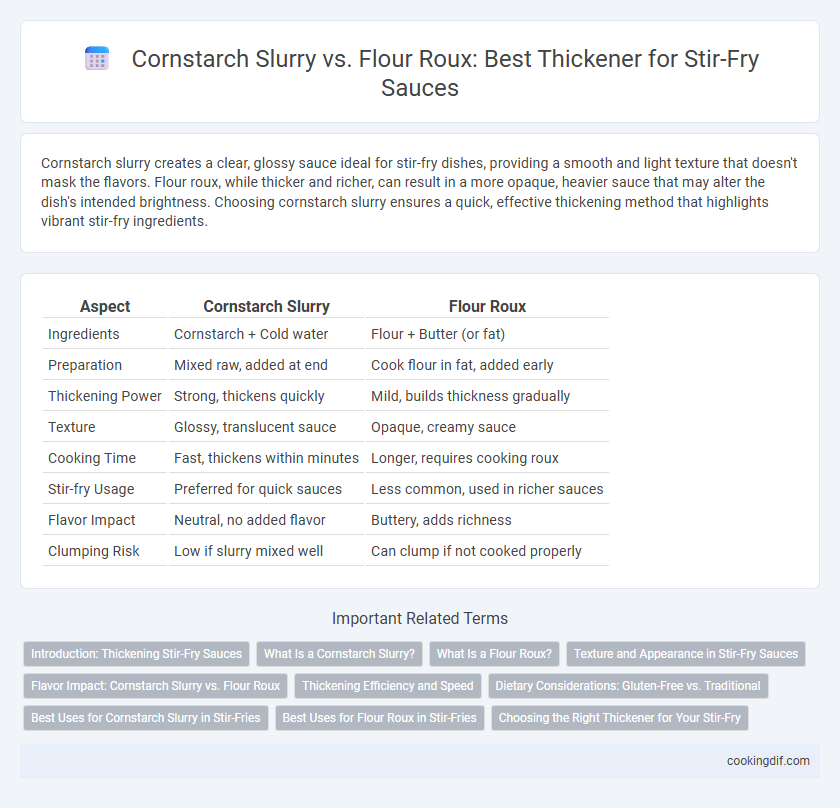Cornstarch slurry creates a clear, glossy sauce ideal for stir-fry dishes, providing a smooth and light texture that doesn't mask the flavors. Flour roux, while thicker and richer, can result in a more opaque, heavier sauce that may alter the dish's intended brightness. Choosing cornstarch slurry ensures a quick, effective thickening method that highlights vibrant stir-fry ingredients.
Table of Comparison
| Aspect | Cornstarch Slurry | Flour Roux |
|---|---|---|
| Ingredients | Cornstarch + Cold water | Flour + Butter (or fat) |
| Preparation | Mixed raw, added at end | Cook flour in fat, added early |
| Thickening Power | Strong, thickens quickly | Mild, builds thickness gradually |
| Texture | Glossy, translucent sauce | Opaque, creamy sauce |
| Cooking Time | Fast, thickens within minutes | Longer, requires cooking roux |
| Stir-fry Usage | Preferred for quick sauces | Less common, used in richer sauces |
| Flavor Impact | Neutral, no added flavor | Buttery, adds richness |
| Clumping Risk | Low if slurry mixed well | Can clump if not cooked properly |
Introduction: Thickening Stir-Fry Sauces
Cornstarch slurry is a preferred thickening agent in stir-fry sauces due to its ability to create a glossy, translucent finish without altering the sauce's flavor. Unlike flour roux, which requires cooking butter and flour together and can impart a heavier texture, cornstarch slurry thickens quickly when added at the end of cooking. This method ensures a smooth, velvety consistency that clings well to ingredients, enhancing the overall dish.
What Is a Cornstarch Slurry?
A cornstarch slurry is a mixture of cornstarch and cold water used to thicken sauces quickly in stir-fry dishes. Unlike a flour roux, which is cooked with fat before adding liquids, the slurry is added directly to hot sauces to achieve a clear, glossy finish without altering flavor. This method provides a smooth texture and fast thickening ideal for vibrant, delicate stir-fry sauces.
What Is a Flour Roux?
A flour roux is a mixture of flour and fat, typically butter or oil, cooked together to create a thickening agent for sauces and gravies. In stir-fry sauces, a roux provides a rich, smooth texture and enhances flavor through the browning of flour during cooking. Unlike a cornstarch slurry, which thickens quickly and yields a glossy finish, a flour roux offers a more complex taste and stable consistency ideal for heartier sauces.
Texture and Appearance in Stir-Fry Sauces
Cornstarch slurry creates a glossy, translucent sauce with a smooth, velvety texture, ideal for achieving the classic shiny finish in stir-fry dishes. Flour roux produces a thicker, opaque sauce with a richer, creamier consistency, often resulting in a heavier mouthfeel. Choosing cornstarch slurry enhances the vibrant look and light texture, while flour roux offers a more substantial body but can dull the sauce's appearance.
Flavor Impact: Cornstarch Slurry vs. Flour Roux
Cornstarch slurry creates a glossy, translucent sauce that preserves the vibrant flavors of stir-fry ingredients, while flour roux yields a richer, creamier texture with a slightly nutty taste due to the cooked flour. Cornstarch thickening keeps the dish light and allows spices and aromatics to shine without altering the sauce's original flavor profile. Flour roux adds a depth of flavor but can mask delicate notes in quick-cooked stir-fry sauces.
Thickening Efficiency and Speed
Cornstarch slurry thickens sauces more efficiently and rapidly than flour roux, achieving a glossy, translucent finish with just a brief simmer. Flour roux requires longer cooking times and higher heat to develop its full thickening potential, often resulting in a denser, opaque sauce. For quick, vibrant stir-fry sauces, cornstarch slurry delivers superior thickening speed and clarity.
Dietary Considerations: Gluten-Free vs. Traditional
Cornstarch slurry is a preferred thickening agent in stir-fry sauces for those following a gluten-free diet, as it contains no gluten and provides a clear, glossy finish. Flour roux, made from wheat flour and fat, offers a richer flavor but is unsuitable for individuals with gluten intolerance or celiac disease. Choosing cornstarch ensures the sauce remains safe for gluten-sensitive diners while maintaining desired thickness and texture.
Best Uses for Cornstarch Slurry in Stir-Fries
Cornstarch slurry is ideal for stir-fries that require a clear, glossy sauce with a smooth texture, as it thickens quickly without clouding the dish. It's best used in recipes with delicate flavors or light-colored sauces, such as chicken with vegetables or seafood stir-fries, where preserving the sauce's clarity enhances presentation. Unlike flour roux, cornstarch slurry provides a faster thickening process and a more translucent finish, making it the preferred choice for authentic Asian stir-fry sauces.
Best Uses for Flour Roux in Stir-Fries
Flour roux excels in stir-fries that benefit from a rich, creamy texture and a slightly toasted flavor, such as in traditional Chinese or French-inspired sauces. It provides a stable, glossy finish ideal for thicker, slow-simmered sauces with meat or vegetables. Use flour roux when you want a more complex, velvety sauce that holds heat well and enhances the umami of the stir-fry ingredients.
Choosing the Right Thickener for Your Stir-Fry
Cornstarch slurry offers a glossy, translucent finish and thickens sauces quickly at high heat, making it ideal for stir-fry dishes that require a light, smooth texture. Flour roux provides a richer, more opaque sauce with a slightly nutty flavor but takes longer to cook and is better suited for slower-cooked or braised dishes. Selecting cornstarch slurry ensures a pristine sauce consistency without altering the stir-fry's vibrant flavors and colors.
cornstarch slurry vs flour roux for thickening sauce Infographic

 cookingdif.com
cookingdif.com